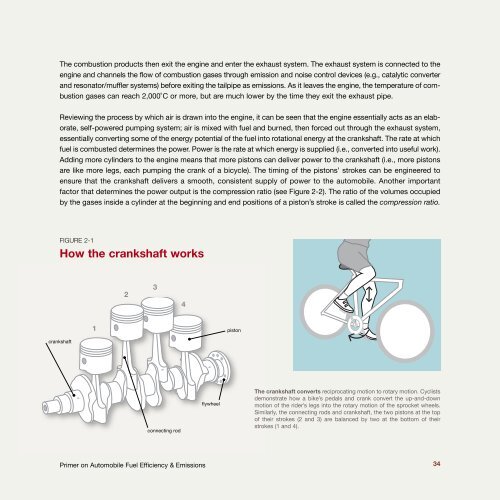Primer on Automobile Fuel Efficiency and Emissions - Pollution Probe
Primer on Automobile Fuel Efficiency and Emissions - Pollution Probe
Primer on Automobile Fuel Efficiency and Emissions - Pollution Probe
Create successful ePaper yourself
Turn your PDF publications into a flip-book with our unique Google optimized e-Paper software.
The combusti<strong>on</strong> products then exit the engine <strong>and</strong> enter the exhaust system. The exhaust system is c<strong>on</strong>nected to the<br />
engine <strong>and</strong> channels the flow of combusti<strong>on</strong> gases through emissi<strong>on</strong> <strong>and</strong> noise c<strong>on</strong>trol devices (e.g., catalytic c<strong>on</strong>verter<br />
<strong>and</strong> res<strong>on</strong>ator/muffler systems) before exiting the tailpipe as emissi<strong>on</strong>s. As it leaves the engine, the temperature of combusti<strong>on</strong><br />
gases can reach 2,000˚C or more, but are much lower by the time they exit the exhaust pipe.<br />
Reviewing the process by which air is drawn into the engine, it can be seen that the engine essentially acts as an elaborate,<br />
self-powered pumping system; air is mixed with fuel <strong>and</strong> burned, then forced out through the exhaust system,<br />
essentially c<strong>on</strong>verting some of the energy potential of the fuel into rotati<strong>on</strong>al energy at the crankshaft. The rate at which<br />
fuel is combusted determines the power. Power is the rate at which energy is supplied (i.e., c<strong>on</strong>verted into useful work).<br />
Adding more cylinders to the engine means that more pist<strong>on</strong>s can deliver power to the crankshaft (i.e., more pist<strong>on</strong>s<br />
are like more legs, each pumping the crank of a bicycle). The timing of the pist<strong>on</strong>s’ strokes can be engineered to<br />
ensure that the crankshaft delivers a smooth, c<strong>on</strong>sistent supply of power to the automobile. Another important<br />
factor that determines the power output is the compressi<strong>on</strong> ratio (see Figure 2-2). The ratio of the volumes occupied<br />
by the gases inside a cylinder at the beginning <strong>and</strong> end positi<strong>on</strong>s of a pist<strong>on</strong>’s stroke is called the compressi<strong>on</strong> ratio.<br />
FIGURE 2-1<br />
How the crankshaft works<br />
2<br />
3<br />
4<br />
1<br />
pist<strong>on</strong><br />
crankshaft<br />
c<strong>on</strong>necting rod<br />
flywheel<br />
The crankshaft c<strong>on</strong>verts reciprocating moti<strong>on</strong> to rotary moti<strong>on</strong>. Cyclists<br />
dem<strong>on</strong>strate how a bike’s pedals <strong>and</strong> crank c<strong>on</strong>vert the up-<strong>and</strong>-down<br />
moti<strong>on</strong> of the rider’s legs into the rotary moti<strong>on</strong> of the sprocket wheels.<br />
Similarly, the c<strong>on</strong>necting rods <strong>and</strong> crankshaft, the two pist<strong>on</strong>s at the top<br />
of their strokes (2 <strong>and</strong> 3) are balanced by two at the bottom of their<br />
strokes (1 <strong>and</strong> 4).<br />
<str<strong>on</strong>g>Primer</str<strong>on</strong>g> <strong>on</strong> <strong>Automobile</strong> <strong>Fuel</strong> <strong>Efficiency</strong> & Emissi<strong>on</strong>s<br />
34
















